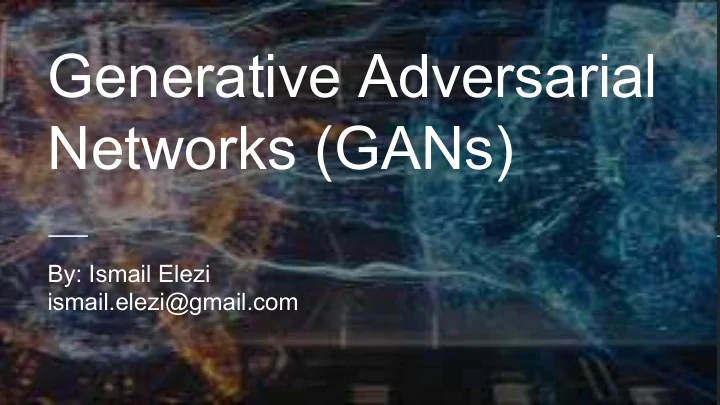

Generative Adversarial Networks (GANs) By: Ismail Elezi ismail.elezi@gmail.com
Supervised Learning vs Unsupervised Learning
Supervised Learning vs Unsupervised Learning
Supervised Learning vs Unsupervised Learning
Supervised Learning vs Unsupervised Learning
Supervised Learning vs Unsupervised Learning
Supervised Learning vs Unsupervised Learning
Supervised Learning vs Unsupervised Learning
Supervised Learning vs Unsupervised Learning
Generative Adversarial Networks
Generative Adversarial Networks Credit: Thilo Stadelmann
Minimax Game on GANs
Minimax Game on GANs
Minimax Game on GANs
Minimax Game on GANs
Minimax Game on GANs
Alternative Cost Function
GAN Training Algorithm Ian Goodfellow et al, Generative Adversarial Networks, NIPS 2014
Generating Digits https://github.com/TheRevanchist/Generative_Adversarial_Networks/tree/master/gan
Conditional GANs What if we want to generate only images of one particular class. Idea: Give the labels of the classes (in one-hot format) to both the generator and discriminator. For the generator concatenate the noise coming from latent space with the one hot vector. Similarly, the discriminator receives in input both the image and its label.
Conditional GANs Mirza and Osindero, Conditional Generative Adversarial Networks, NIPS 2014
Generating Digits https://github.com/TheRevanchist/Generative_Adversarial_Networks/tree/master/cgan
Any idea how to improve GANs?
Deep Convolutional GANs (DCGAN) Radford, Metz and Chintala, Unsupervised Representation Learning with Deep Convolutional Generative Adversarial Networks, ICLR 2016
Deep Convolutional GANs (DCGAN) Radford, Metz and Chintala, Unsupervised Representation Learning with Deep Convolutional Generative Adversarial Networks, ICLR 2016
Deep Convolutional GANs (DCGAN) Radford, Metz and Chintala, Unsupervised Representation Learning with Deep Convolutional Generative Adversarial Networks, ICLR 2016
Radford, Metz and Chintala, Unsupervised Representation Learning with Deep Convolutional Generative Adversarial Networks, ICLR 2016
However, During Training
Mode Collapse https://github.com/TheRevanchist/Generative_Adversarial_Networks/tree/master/dcgan
Possible Fixes to Mode Collapse - (Not scientific) Soft labeling, instead of giving to the discriminator labels 1/0, give to it 0.8/0.2 - (Definitely not scientific) Checkpoint the net, and every time mode collapse occurs, load the net from the previous checkpoint. - (A bit more scientific) LSGAN, other types of cost functions. - (Scientific) Wasserstein GAN - (Even more scientific) Improved Wasserstein GAN, Dirac Gan etc
The GAN Zoo https://github.com/hindupuravinash/the-gan-zoo
Does it Really Matter?! Lucic et al, Are GANs Created Equal? A Large-Scale Study, NIPS 2018
Goodfellow, CVPR tutorial, 2018
Goodfellow, CPVP tutorial, 2018
Goodfellow, CPVP tutorial, 2018
Goodfellow, CPVP tutorial, 2018
GANs for Time Series Hyland et al, Real-valued (medical) time series generation with recurrent conditional GANs, arXiv 2017
Efros, ICCV tutorial, 2017
Efros, ICCV tutorial, 2017
For much more look at: https://github.com/junyanz/pytorch-CycleGAN-and-pix2pix
My GAN-story
Problems 1) Our images are 2000 x 2000. At 700 (+ delta) by 700 (+delta) images, even a VOLTA V100 runs out of memory
Problems 1) Our images are 2000 x 2000. At 700 by 700 images, even a VOLTA V100 runs out of memory - Solution 1: train in patches, generate large images.
Problems 1) Our images are 2000 x 2000. At 700 by 700 images, even a VOLTA V100 runs out of memory - Solution 1: train in patches, generate large images. It doesn’t work.
Problems 1) Our images are 2000 x 2000. At 700 by 700 images, even a VOLTA V100 runs out of memory - Solution 1: train in patches, generate large images. It doesn’t work. - Solution 2: make the nets more efficient. Train on float16 (NVIDIA Apex) and use gradient checkpointing.
Problems 1) Our images are 2000 x 2000. At 700 by 700 images, even a VOLTA V100 runs out of memory - Solution 1: train in patches, generate large images. It doesn’t work. - Solution 2: make the nets more efficient. Train on float16 (NVIDIA Apex) and use gradient checkpointing. It works.
Digression: Half precision training
Digression: Gradient Checkpointing
Digression: Gradient Checkpointing
Digression: Gradient Checkpointing
Digression: Gradient Checkpointing https://github.com/TheRevanchist/pytorch-CycleGAN-and-pix2pix
Problems 1) Our images are 2000 x 2000. At 700 by 700 images, even a VOLTA V100 runs out of memory - Solution 1: train in patches, generate large images. It doesn’t work. - Solution 2: make the nets more efficient. Train on float16 (NVIDIA Apex) and use gradient checkpointing. It works. 2) Bigger images, less likely that we will be able to generate meaningful images (mode collapse)
Problems 1) Our images are 2000 x 2000. At 700 by 700 images, even a VOLTA V100 runs out of memory - Solution 1: train in patches, generate large images. It doesn’t work. - Solution 2: make the nets more efficient. Train on float16 (NVIDIA Apex) and use gradient checkpointing. It works. 2) Bigger images, less likely that we will be able to generate meaningful images (mode collapse) - Solution 1: more careful training and hyperparameter optimization. - Solution 2: different loss functions, maybe Wasserstein GANs (or the improved version of it), researchy stuff. - Solution 3: progressive training and/or BigGan-inspired approach.
Thank You!
Recommend
More recommend